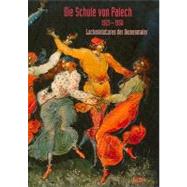Die Schule Von Palech
, by Kopplin, Monika- ISBN: 9783777432014 | 3777432016
- Cover: Hardcover
- Copyright: 12/31/2010
English summary: Triggered by the October Revolution and by government-imposed atheism, religious art in Russia abruptly saw the legs knocked out from underneath it in 1917. In Palekh, an ancient center of icon painting, artists turned to lacquer miniatures in search for a livelihood and new artistic direction. After tentative beginnings under the influence of Art Deco, the transformation of religious motives and of a traditional style vocabulary became part of young Soviet art. In the center of this movement stood the painter Ivan Golikov, who together with six other former icon artists in Palekh brought the "cooperative for old painting" to life in 1924. Golikov's paintings were at the same time the starting point and the high point of the early Palekh style, which was adapted in individual form by all the other painters of the time. With the tenth anniversary of the revolution in 1927, the targets and achievements of socialism were brought to the foreground as a dominant theme. The radical reconstruction of society and the transformation from an agricultural to an industrial state was celebrated in striking compositions. Since the late thirties, increasinlgy so from 1941 onwards, the theme of these pieces transitioned from threat and struggle to triumphant scenes of victory. For the first time, the origins of the Russian school of Palekh are traced using the abundant pool of important collections, and are presented in the exhibition and catalog. German text. German description: In der Hinwendung zur Lackminiatur suchten die Palecher Ikonenmaler nach der Oktoberrevolution eine neue kunstlerische Ausrichtung. Die Errungenschaften des Sozialismus, aber auch Bilder der Bedrohung und des Krieges dokumentieren eindringlich die Entwicklung des jungen sowjetischen Staates. Ausgelost von der Oktoberrevolution und dem staatlich verordneten Atheismus, war der religiosen Kunst in Russland seit 1917 schlagartig der Boden entzogen. In Palech, einem alten Zentrum der Ikonenmalerei, suchten die betroffenen Maler in der Hinwendung zur Lackminiatur ein Auskommen und eine neue kunstlerische Ausrichtung. Nach tastenden Anfangen unter dem Einfluss des Art deco gelang die Transformation religioser Motive und eines tradierten Stilvokabulars in die junge sowjetische Kunst. Im Zentrum dieses Geschehens stand der Maler Iwan Golikow, der gemeinsam mit sechs weiteren ehemaligen Ikonenkunstlern 1924 die Palecher "Genossenschaft fur alte Malerei" ins Leben rief. Golikows Malerei sollte Ausgangspunkt und Hohepunkt des fruhen Palecher Stils zugleich sein, den sich bei aller individuellen Auspragung auch die anderen Maler zu Eigen machten. Mit der Zehnjahresfeier der Revolution 1927 traten die Ziele und Errungenschaften des Sozialismus als dominierendes Thema in den Vordergrund. Der radikale Umbau der Gesellschaft und der Wandel vom Agrar- zum Industriestaat wurde in plakativ anmutenden Kompositionen gefeiert. Schon seit den spaten dreissiger Jahren und verstarkt von 1941 an wichen sie Bildern der Bedrohung und des Kampfes von dusterer Eindringlichkeit, schliesslich den triumphalen Szenen des Sieges. Erstmalig wird in Ausstellung und Katalog aus dem reichen Fundus der bedeutendsten russischen Sammlungen das Werden der Palecher Schule nachgezeichnet.






